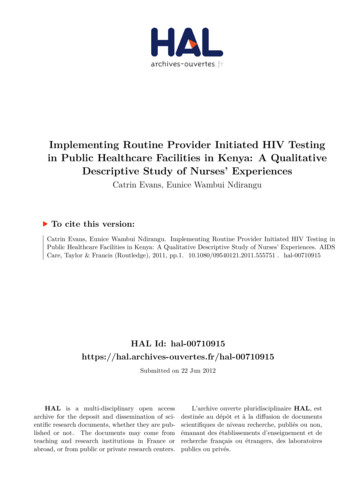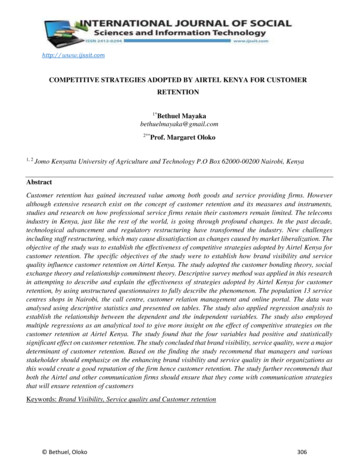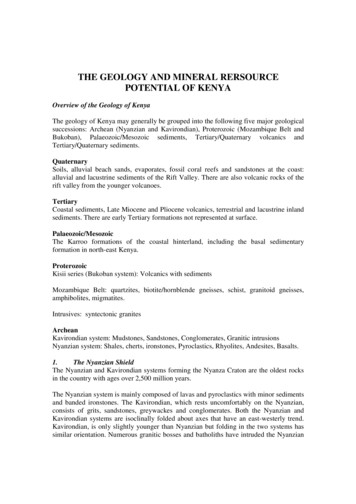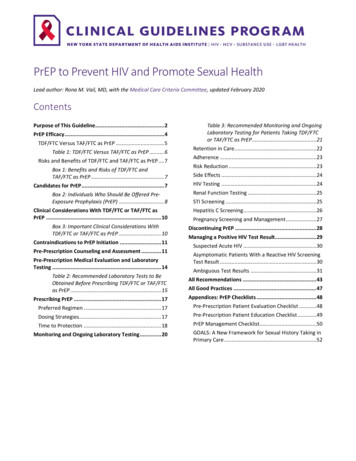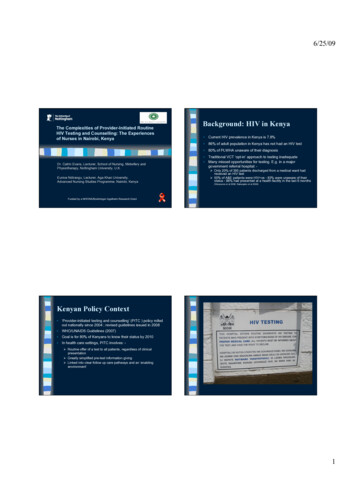
Transcription
6/25/09The Complexities of Provider-Initiated RoutineHIV Testing and Counselling: The Experiencesof Nurses in Nairobi, KenyaBackground: HIV in Kenya Current HIV prevalence in Kenya is 7.8% 86% of adult population in Kenya has not had an HIV test 80% of PLWHA unaware of their diagnosisDr. Catrin Evans, Lecturer, School of Nursing, Midwifery andPhysiotherapy, Nottingham University, U.K.Eunice Ndirangu, Lecturer, Aga Khan University,Advanced Nursing Studies Programme, Nairobi, Kenya Traditional VCT ‘opt-in’ approach to testing inadequate Many missed opportunities for testing. E.g. in a majorgovernment referral hospital: Only 20% of 395 patients discharged from a medical ward hadreceived an HIV test 50% of A&E patients were HIV ve - 83% were unaware of theirstatus - 86% had presented at a health facility in the last 6 months(Wanyenze et al 2006, Nakanjako et al 2006)Funded by a NHIVNA/Boehringer Ingelheim Research GrantKenyan Policy Context ‘Provider-initiated testing and counselling’ (PITC ) policy rolledout nationally since 2004 ; revised guidelines issued in 2008 WHO/UNAIDS Guidelines (2007) Goal is for 80% of Kenyans to know their status by 2010 In health care settings, PITC involves: Routine offer of a test to all patients, regardless of clinicalpresentation Greatly simplified pre-test information giving Linked into clear follow up care pathways and an ‘enablingenvironment’1
6/25/09Concerns about the PITC Policy: The 4 C’s In a Ugandan medical ward, only 29% of patients given a testhad received any pre-test counselling (Wanyenze et al 2006) In a S.African study: 88% of antenatal women felt pressuredto give consent (Boyd et al 1999) In Botswana: 68% of population sample said they would beunable to refuse a medically recommended test (Weiser et al2006) Rates of return for follow up is highly variable S.African studies indicate that nurses find PITC a stressfuland difficult job due to the emotional burdens of the work andfeeling unsupported in their work environments (Mavhandu-Mudzusi, Netshandama, & Dhavhana-Maselesele, 2007; Mkhabela, Mavundla,& Sukati, 2008).What about the Nurses?MethodologyStudy Aims Exploratory qualitative design1.To investigate nurses’ views on, and experiences with,PITC2.From a nursing perspective, to identify the challenges andfacilitators of good practice in implementing routine HIVtesting and counselling Purposive sample: nurses working in 9 different hospitals, 3health centres & 1 NGO - in & around Nairobi 15 semi-structured interviews 2 focus groups discussions (total participants 12) Thematic data analysis Ethical procedures followed2
6/25/09Initial (Descriptive) ThemesTHEMESSUB-THEMESViews on PITCBarriers to testingBenefits of PITCPossible drawbacks with PITCExperiences ofImplementing PITCPre-test process & informed consentPost-test support & confidentialityCounselling challenges: dealing with people the organisational contextExpanded Role of Nursesin HIV TestingAutonomyBurn OutProfessional resistanceInvolvement in policy makingNurses’ Views on PITC Will help to ‘normalise’ HIVWill save lives & support preventionEnables easier communication about testingMay undermine trust & deter some peopleCaution re. women & need to ensure an ethical process is followedBefore, on the ward they even die without anyone checking what theproblem is - now, if you catch them early there is that hope (P6)Before, a patient will come - inside his heart wanting to do the test - butjust asking you would be a problem for him (P15)Both were positive - the man started abusing the woman – that she is theone who has brought HIV into their home. I found out later that he lefther (FGD1)Experiences of Implementing PITC: Pre-Test & ConsentExperiences of Post-Test Support: Confidentiality Concerns about reduced pre-test discussion Nurses adhere to guidelines but problems still arise Informed consent or informed coercion? Patients need considerable post-test support & follow up Nurses identified many challenges to maintaining confidentialitySometimes there is no time and you rush it over and you wish you had moretime to talk to this patient in a broad way (P3)This lady was very sick, she was depressed. .it was so challenging becauseshe is thinking she is going to die, so you have to give her some hope (P5)So the blood is drawn and the test is done .and no, the results are nottold there’s a closed awareness - you know the staff know but the patientdoesn’t (FGD1)In our government wards we don’t have cubicles .so it forces us to go bedby bed as we give a report .patients have come to realise the language weuse and then you say “this immuno-suppressed patient” and it just gives thewhole story to the others (FGD1)You might be aggressive for the sake of helping them just because youwant them to benefit even though you have to use a cold and aggressive wayof handling the situation (P2)We remove blood - then it is taken to another facility for testing – in mostcases it is the relatives who bring the results back - so we actually breachconfidentiality (FGD1)3
6/25/09Counselling Challenges: Dealing with People Extreme patient reactionsEthical dilemmas (e.g. managing disclosure)Getting emotionally involvedBefore I knew it, he started punching me, I was alone in the room and had toscream so my colleagues came (FGD1)You know, disclosure takes time, you have to give the patient time. Someclients take long to accept - you cannot force them (P7)Most people die, not because they have not accepted, but because they arepoor and cannot afford good food – this really affects me (P2)Expanding the Nurse’s Role in PITCIt was a new role for nursing, which .had also been the missing link inassisting our patients to understand HIV/AIDS at an early stage I felt atlast I had ownership of HIV patients because my opinion on managementand treatment was highly regarded (P2)If you look at all the programme implementation, anything on HIV, itends up with the nurse. If the nurse does not implement, then the wholeprogramme falls back. But if you look at who is being rewarded for thatparticular programme, the nurse is at the back, so you see there is a lot ofde-motivation and if a new programme comes it is received with a lot ofnegativity because it is an increase in their work load The nurse isdoing the work of the clinician, the doctor, the clerk, and even acounsellor You have been saying that the nurse is the back bonebut it is coming to a time when the back bone is breaking so someoneneeds to recognise that (FGD2:3)Counselling Challenges: Organisational Context Lack of time, resources & staff Need for more training, supervision & support Target driven rather than patient centred approachLike when you have the donors who maybe funded the training, they also wanttheir numbers to justify the money for the training. So you find that they arepressurizing the staff such that you are given numbers - if you do not testthis many numbers then you are a failure and the providers arewondering where this 50 will come from, if we coerce these patients to betested then we are going to sound a scaring alarm to most of them who arecoming around and they won’t even come. And then it won’t be providerinitiated, it will be provider-coercion (FGD2:3).Nursing and HIV Testing Policy DevelopmentI would say that so long as our state policy shallcontinue to be formulated in ivory towers, and the nursesand the patients, the consumers, are never involved - weshall continue to suffer. So long as people come thereand they sit in Grand Regency, sit in Intercontinentaland they say, now, let us introduce a newprogram but we are not going to downthere to see this nurse who has seventy patients . Peopleare creating policy up there, they are not coming down(FG1).4
6/25/09What Next?Conclusions PITC generally welcomed & recognised as an importantpublic health strategy Need ongoing guidance, training & peer support/mentorship,especially re. ethical ‘grey areas’ & difficult patients PITC has the potential to develop and enrich nurses’ role Study results have been reported back to participants and seniornursing officials and organisations through regional conferences inEast Africa PITC policy review article published in an international peer reviewedjournal Findings will also be submitted for publication in an international peerreviewed journal Major gap in the work on PITC is the patient experience and thepatient journey Further research now underway Need to involve nurses in service development and policymaking Need attention to recognition, resources, facilities andstaffingAcknowledgements NHIVNA/BI Grant All the nurses who gave up their time toparticipate in this studyThank you!Any Questions?5
6/25/09 2 Concerns about the PITC Policy: The 4 C’s In a Ugandan medical ward, only 29% of patients given a test had received any pre-test counselling (Wanyenze et al 2006) In
